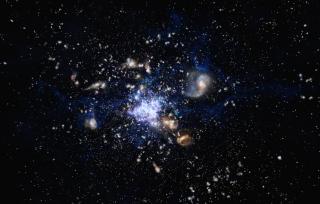Bibcode
Battisti, A. J.; da Cunha, E.; Grasha, K.; Salvato, M.; Daddi, E.; Davies, L.; Jin, S.; Liu, D.; Schinnerer, E.; Vaccari, M.; (COSMOS Collaboration
Referencia bibliográfica
The Astrophysical Journal, Volume 882, Issue 1, article id. 61, 21 pp. (2019).
Fecha de publicación:
9
2019
Revista
Número de citas
76
Número de citas referidas
69
Descripción
We present an enhanced version of the multiwavelength spectral modeling
code MAGPHYS that allows the estimation of galaxy photometric redshift
and physical properties (e.g., stellar mass, star formation rate, dust
attenuation) simultaneously, together with robust characterization of
their uncertainties. The self-consistent modeling over ultraviolet to
radio wavelengths in MAGPHYS+photo-z is unique compared to standard
photometric redshift codes. The broader wavelength consideration is
particularly useful for breaking certain degeneracies in color versus
redshift for dusty galaxies with limited observer-frame ultraviolet and
optical data (or upper limits). We demonstrate the success of the code
in estimating redshifts and physical properties for over 4000
infrared-detected galaxies at 0.4 < z < 6.0 in the COSMOS field
with robust spectroscopic redshifts. We achieve high photo-z precision
({σ }{{Δ }z/(1+{z}spec})}≲ 0.04),
high accuracy (i.e., minimal offset biases; median(Δz/(1 + z
spec)) ≲ 0.02), and low catastrophic failure rates
(η ≃ 4%) over all redshifts. Interestingly, we find that a weak
2175 Å absorption feature in the attenuation curve models is
required to remove a subtle systematic z phot offset
({z}phot}{--}{z}spec}≃ -0.03) that occurs
when this feature is not included. As expected, the accuracy of derived
physical properties in MAGPHYS+photo-z decreases strongly as redshift
uncertainty increases. The all-in-one treatment of uncertainties
afforded with this code is beneficial for accurately interpreting
physical properties of galaxies in large photometric data sets. Finally,
we emphasize that MAGPHYS+photo-z is not intended to replace existing
photo-z codes, but rather offers flexibility to robustly interpret
physical properties when spectroscopic redshifts are unavailable. The
MAGPHYS+photo-z code is publicly available online.
Proyectos relacionados

Gas Molecular y Polvo en Galacias através del Tiempo Cósmico
Dos cuestiones fundamentales en la Astrofísica son la conversión de gas molecuar en estrellas y cómo este proceso físico depende del entorno en todas las escalas, desde sistemas planetarios, cúmulos estelares, galaxias hasta cúmulos de galaxias. El objectivo principal de este proyecto es el de estudiar la formación y evolución de galaxias a partir
Helmut
Dannerbauer